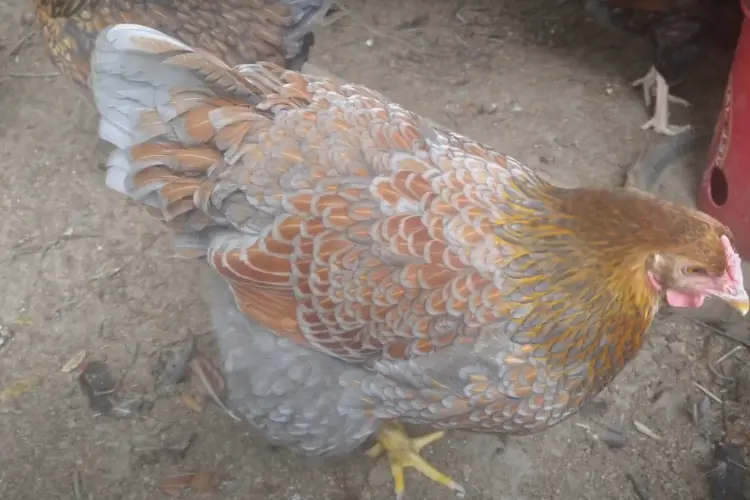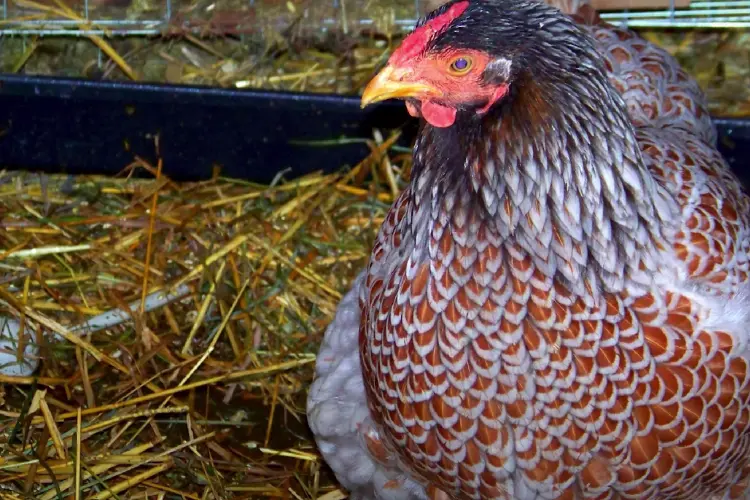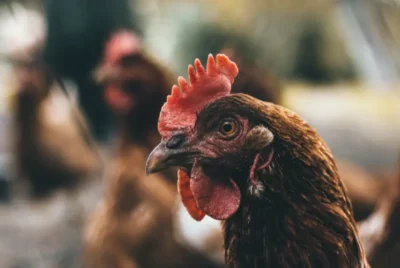How to Care for Your Blue Laced Red Wyandotte
Are you struggling to provide optimal care for your Blue Laced Red Wyandotte? Perhaps you’re dealing with issues such as poor egg production, health concerns, or even difficulty understanding the unique needs of this beautiful breed.
As a backyard poultry enthusiast or small-scale farmer, it’s frustrating when you feel you’re not able to meet your flock’s needs or enhance their well-being as you’d like to. So in this article, we will give you the knowledge you need to give these magnificent birds the best care possible.
Quick Stats of Blue Laced Red Wyandotte Breed
- Category: American
- Heritage Variety: Yes
- Rare Variety / TLC Conservation Priority Level: Under Observation
- Egg Shade: Brown
- Egg Dimensions: Medium-Sized
- Egg Yield: High
- Temperament: Outstanding
- Brooder (Inclination to Nest): Moderately Likely
- Foraging Capability: Outstanding
- Resilience to Heat: High
- Resilience to Cold: Outstanding
- Comb Style: Rose
- Leg Structure: Unfeathered
- Leg Hue: Yellow
- Skin Hue: Yellow
- Bird Dimensions: Large
- Meat Yield: High
- Age at Full Growth: 20 weeks
- Weight at Maturity (Male): 8.5 lbs
- Weight at Maturity (Female): 6.5 lbs
Physical Appearance of Blue Laced Red Wyandotte Breed
The Blue Laced Red Wyandotte is a striking breed of the large Wyandotte family. This fluffy chicken breed displays a unique blend of colors and traits that make it highly distinctive. Its behavior, size, and color make it a favorite among many poultry keepers.
Appearance
The adult Blue Laced Red Wyandotte is a large, round bird with a small, red comb and matching red wattles. They have light yellow legs which, while appearing short, can comfortably support their hefty weight. Their heads feature a rose comb, which, along with their wattles and earlobes, are red, and their eyes are a deep-set red bay color, located just above a horn-hued beak.
One of the defining features of this breed is its dense, multicolored feathering. Their neck feathers are blue, blending into the deep red feathers on their heads. The back feathers exhibit a red/chestnut shade, and their belly feathers bear a similar hue, accentuated by a thin blue/gray line. The under-feathers maintain this blue/gray coloration, contributing to their stunning appearance.
Size and Weight
Wyandottes, in general, are large chickens. However, the abundance of their fluffy feathers makes them look even larger than they are. The hens of this breed weigh approximately 6.5 pounds, and roosters can reach a weight of about 8.5 pounds, which aligns with the breed’s overall large size.
Color
The Wyandotte’s color is perhaps its most distinctive feature. The feathers on the back and belly are a rich red/chestnut color, but what sets this breed apart is the thin blue/gray lacing present on these feathers.
The same blue/gray coloration is found on their under-feathers. This unique combination of red and blue/gray feathers gives the Blue Laced Red Wyandotte its name and appealing visual traits.

Personalities of Blue Laced Red Wyandotte Breed
Activity and Social Interaction
Wyandottes are busy chickens, usually seen hunting for food. They love to wander freely and explore the yard. They are good at finding food like seeds and bugs when they wander around. When you see them with other chickens, Wyandottes might seem like they keep to themselves. They like spending time with their kind more than other breeds.
Personality
Wyandottes are calm and friendly chickens. They are not easily upset and are quiet and peaceful. They are not mean, but they will stand up for themselves if other chickens bother them. They can be friendly to those caring for them, but they prefer not to be held too much.
Even though they don’t often sit on eggs to hatch them, they are very caring mothers to their chicks when they do.
Egg Production
Blue Laced Red Wyandottes are good at laying eggs. They can give around 4 big brown eggs every week, adding up to around 200 eggs every year. They usually start laying eggs between 16 and 20 weeks old. When they sit on eggs, they are happy to sit on any eggs given to them. Wyandottes can have some problems with getting eggs to hatch, so making baby chickens can be a bit hard.

Noise Levels
They are usually quiet chickens. They talk to each other softly. They are noisiest when they lay eggs, give a warning, or when the male chickens crow.
Broodiness
These chickens don’t often sit on eggs to hatch them, but when they do, they are excellent mothers. They will take care of any eggs put under them and keep them warm until they hatch. However, because of their fluffy feathers, they might have trouble getting the eggs to hatch, so they can be a bit hard to breed.
Temperament
Wyandottes are friendly and calm chickens. They stay calm around people, including kids. They don’t mind being held if they got used to it when they were young, but they are not the type to sit on laps.
They are also very good at adjusting to different situations, whether you keep them in a coop or let them wander freely. They are good as long as they have what they need. These qualities make them a great choice for people new to raising chickens.
Health Concerns of Blue Laced Red Wyandotte Breed
Blue Laced Red Wyandottes are mostly healthy birds. They can, however, have low fertility and can be more at risk of problems when it’s hot. Many of the health problems they do get are common in most types of chickens.
Parasites
Chickens can often get parasites like mites, lice, and worms. To stop this, you can give your chickens medicine regularly. Regularly cleaning their bedding and bowls can also help stop parasites from spreading. Another way to keep parasites out of the chickens’ feathers is by giving them dust baths.
Feather Maintenance
These beautiful birds have a lot of feathers around their rear end. This isn’t only a problem when breeding. It can also cause feces and other things to get stuck in their feathers.
So, even if you’re not planning to breed your chickens, it’s good to regularly trim the feathers on their bottoms. This can stop a blockage from happening.
Breeding Issues
Blue Laced Red Wyandottes are very popular. Because of this, some people carelessly breed them. They might breed lower-quality birds, which can cause the chicks to have more health problems. To avoid buying sick birds, make sure to only buy from breeders who have a good reputation.

Blue Laced Red Wyandotte Care Instructions
Feeding
Just like all chicken breeds, Blue Laced Red Wyandottes should always have access to clean water and food. As chicks, they should be fed high-protein crumble containing about 20% protein since it’s easier for them to swallow than pellets. Once they reach 16 weeks, their diet can gradually shift to a 16% protein-layered feed in either crumble or pellet form.
Providing additional calcium is vital for laying hens, and this can be supplemented through oysters served separately from the rest of the meal or cooked crumbled eggshells. Keep in mind that correct nutrition is critical to their health and development.
In addition to a balanced diet, Wyandottes are excellent foragers. Allowing them free range enables them to consume bugs and other pests, adding to their nutrient intake. Most 6-pound chickens will consume approximately 3 pounds of feed per week.
Chicken Coop Set-up
The housing requirements for Blue Laced Red Wyandottes need to accommodate their larger size and preferences. When building a coop, it’s essential to provide a minimum of eight to ten square feet per bird, with additional space if they share the coop with other chicken breeds to avoid fights.
Perch space is crucial for these larger chickens, and each should be provided with 10 to 12 inches of personal roosting space. During winter, they tend to sit closer together for warmth but will make the most of the extra space during summer.
Nesting boxes should be approximately 12 inches by 12 inches, providing enough room for the hens to be comfortable without allowing nest sharing. Overcrowding nesting boxes could lead to broken eggs.
Wyandottes tolerate confinement well, and providing free-range time isn’t necessary if not desired. However, if they are kept in an enclosure at all times, it must be spacious and filled with items to keep them occupied, like chicken toys.
Considering their limited flying abilities, a 3-4 foot fence is usually sufficient for confinement. Be aware that their limited flying ability could expose them to risks from predators if they can roam freely.
Dealing with Weather
Blue Laced Red Wyandotte chickens have origins in cold climates, making them well adapted to withstand harsh winters. The generous plumage of these gorgeous birds offers effective insulation, ensuring they are kept warm even in snowy and icy conditions. Regardless of their cold resilience, they must always have access to adequate shelter.
Conversely, these birds might struggle in the scorching heat of summer. Chickens generally regulate their body temperatures through their combs, but Wyandottes have small combs, making it challenging for them to cool down in higher temperatures.
To prevent heat-related problems, it’s vital to ensure they have continuous access to shade and water. If you reside in an area that experiences extreme heat during summer, you might need to consider installing a fan in your chicken coop to help alleviate the heat.

Blue Laced Red Wyandotte Chicks Physical Appearance
Blue Laced Red Wyandotte chicks are a delightful sight with their soft, yellow plumage highlighted with tips of darker brown feathers. Determining gender among these chicks can be challenging. However, observable differences between males and females emerge around the eight-week mark.
Males often develop a more robust physical stature at this stage. Their behavior is notably bolder, demonstrating a certain assertiveness and curiosity. In contrast, female chicks typically exhibit quieter and more reserved traits.
Breeding
Breeding Blue Laced Red Wyandotte chickens requires understanding and patience, which can be challenging due to their genetic complexity. They are not a breed true where you can simply mate two individuals and expect to get baby chicks that look exactly like the parents.
The blue lacing in the feathers results from a particular combination of genes, and only about half the chicks from a pair of Blue Laced Red Wyandottes will have the desired lacing. The rest could be black, splash (a white bird with ‘splashes’ of dark blue color), or poorly laced.
History of Blue Laced Red Wyandottes
The Wyandotte chicken breed, including the Blue Laced Red and the Golden laced Wyandotte, has an interesting and unclear history. First bred in the United States in the 1870s, Wyandottes are named after a Native American tribe from New York. The breed’s early ancestors are believed to be a mix of silver-spangled Hamburg and dark Brahma chickens.
Over time, as Wyandottes gained popularity, new color variants like the Blue Laced Red were developed. However, there’s some confusion over where this particular variant was first bred. Some suggest Germany as its birthplace, while others believe it was bred in the U.S. before being exported to Europe.

The driving goal behind the breed’s development was to create a robust chicken in cold weather and be efficient at egg and meat production. Wyandottes, especially the Blue Laced Red, still serve these dual purposes today.
Despite its long history, the Blue Laced Wyandotte wasn’t widely recognized until recently. Today, it is celebrated not only for its gorgeous coloring combination but also for its steady egg-laying capabilities and good meat quality, making it a popular choice among backyard chicken keepers.
Conclusion
Caring for your Blue Laced Red Wyandottes involves much more than providing food and water. A comprehensive approach is necessary for the well-being of these beautiful, docile birds. This guide to chicken world has underscored the importance of meeting their unique needs.
With consistent care and an attentive eye, you can ensure that your Blue Laced Red Wyandotte chicken will live a long, healthy, and happy life while also offering you their high-quality eggs and the companionship that only these unique birds can provide.



